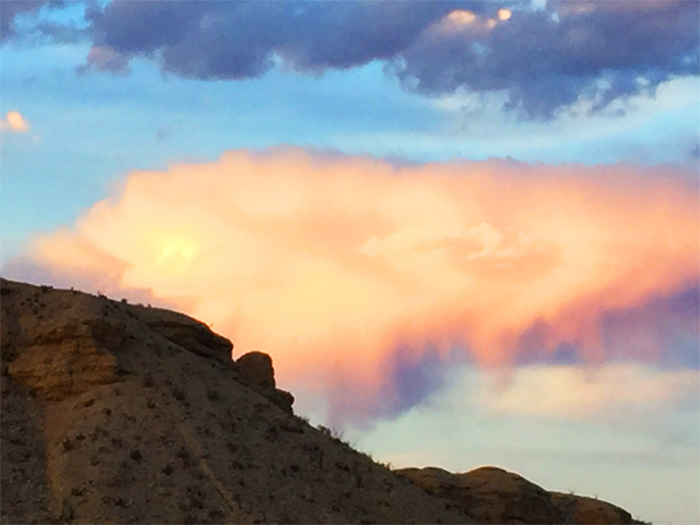
When you look at a cloud, you’re actually looking at billions of microorganisms.
Ever since Darwin found microbes in dust over the Atlantic, they’ve turned up in ever-stranger places:
In dust plumes over mountains. In high-altitude snowfields. And in the tops of clouds.
This means, of course, they’re also in rain. Scientists have identified thousands of species of microbes and fungi living in rain and clouds—able to withstand the harsh temperatures, low oxygen and punishing radiation of the atmosphere.
What we didn’t expect is their complex relationship with clouds and rain.
Clouds are usually born at high altitude, where it’s cold enough for ice crystals to form. To do that, they need a nucleus to form around. Nuclei can be inorganic particles, like dust, salt, or ash. Or they can be organic particles, like microbes.
Recently we’ve discovered that many cloud-dwelling microbes create proteins that mimic the structure of ice crystals, allowing ice—and therefore clouds—to form at higher temperatures and lower altitudes.
As the ice crystals grow and become heavy, they fall through the cloud to become snow, sleet, or rain, carrying the microbes down with them.
On Earth, many of these microbes feed on plant populations, which die and dry up, and the microbes are carried by the wind into the atmosphere again.
This cycle transports microbes around the world, forms more clouds and, with them, more rain.
Background
Synopsis: Whether billowing cumulus or threatening nimbus types, clouds inspire our imagination. But did you know that they are alive? Windswept microbes, which actually build clouds by nucleating ice crystals at lower-than-normal temperatures, are disseminated to new geographies when it rains.
- Ever since Darwin collected microbes in samples of airborne dust in the middle of the Atlantic in the 1830s, scientists have been curious about the role of these tiny organisms in clouds and in the atmosphere.
- Scientists have collected microbes and fungi from dust plumes over mountaintops, from snow in high-altitude regions around the globe, from rain in sterilized funnels mounted 100 ft above the land surface, by direct sampling of clouds over the Pacific, and via NASA flights studying hurricanes at 30,000 ft above land and sea.
- State-of-the-art DNA analyses typically identify dozens to thousands of species surviving in the harsh temperatures, low oxygen, and punishing radiation of the atmosphere.
- Microbes travel long distances around the globe. One study found a type of Archaea in Oregon that previously had only been identified in Japan; Asian microbes had made their way to America in a plume of dust. Microbes also travel with clouds and are dispersed by precipitation when it falls.
- Different types of particulates in the atmosphere are now thought to have different effects on clouds and rain distribution.
- Recent studies have found that certain proteins produced by bacteria serve as a kind of “scaffolding” that simultaneously orients many water molecules into a 3D form very similar to the shape of the ice lattice it makes when it freezes, thus speeding up the nucleation process.
- Clouds form high in the atmosphere, where it is cold enough for condensation, cooling, and saturation to cause ice nucleation to occur, at around -14oC.
- Ice nucleation occurs more rapidly in the presence of cloud condensation nuclei (CCNs), which include tiny inorganic particles called aerosols and even organic particles like microbes and fungi.
- Aerosols such as sea salt, dust, volcanic ash, carbon, nitrates, and sulfates cause haze as well as beautiful sunsets.
- Aerosols stimulate nucleation by orienting a few water molecules so they can begin organizing into solid ice.
- Ice nucleation active (INA) proteins make it possible for ice to form at higher temperatures when these microbes are present, so thicker clouds can form at lower altitudes.
- As clouds are swept around by wind, condensation continues; as ice crystals grow, they become heavy and fall through the clouds as snow, sleet, or rain, depending on the temperature.
- Clouds, rather than being merely water vapor, are also ecosystems, and microbes appear to play a major part in meteorology.
- Most of the INA protein-rich bacteria that promote cloud formation also appear to be plant pathogens—using their ability to cause freezing at slightly warmer temperatures to break through the cell walls of plants they attack and feed upon.
- After decimating plants in one location, these microbes are swirled into the atmosphere by winds, where they speed up the rainmaking process and rain down on healthy plants to start the cycle again—key to survival of their species.
- Although not as common as plant pathogens, certain animal pathogens have also been known to travel through the skies.
- Some scientists attribute a 2001 outbreak of foot-and-mouth disease in Britain to a giant storm in North Africa the week before.
- Declining Caribbean coral reefs may be suffering from microbes and fungi sourced from Saharan dust storms; a fatal sea-fan fungus arrived in 1983.
- In 2015, scientists found that antibiotic-resistant bacteria had a 4,000% higher concentration downwind from cattle feedlots in North Texas.

